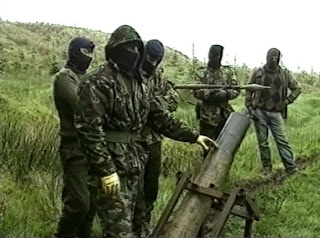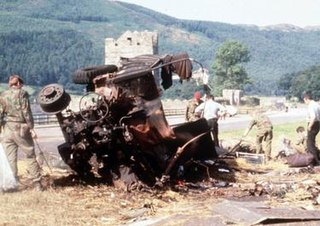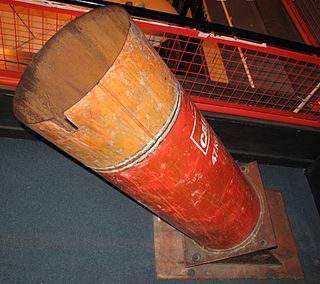Related Research Articles

The South Armagh Brigade of the Provisional Irish Republican Army (IRA) operated during the Troubles in south County Armagh. It was organised into two battalions, one around Jonesborough and another around Crossmaglen. By the 1990s, the South Armagh Brigade was thought to consist of about 40 members, roughly half of them living south of the border. It has allegedly been commanded since the 1970s by Thomas 'Slab' Murphy who is also alleged to be a member of the IRA's Army Council. Compared to other brigades, the South Armagh IRA was seen as an 'independent republic' within the republican movement, retaining a battalion organizational structure and not adopting the cell structure the rest of the IRA was forced to adopt after repeated intelligence failures.

From 1969 until 1997, the Provisional Irish Republican Army (IRA) conducted an armed paramilitary campaign primarily in Northern Ireland and England, aimed at ending British rule in Northern Ireland in order to create a united Ireland.

The Warrenpoint ambush, also known as the Narrow Water ambush, the Warrenpoint massacre or the Narrow Water massacre, was a guerrilla attack by the Provisional Irish Republican Army (IRA) on 27 August 1979. The IRA's South Armagh Brigade ambushed a British Army convoy with two large roadside bombs at Narrow Water Castle outside Warrenpoint, Northern Ireland. The first bomb was aimed at the convoy itself, and the second targeted the incoming reinforcements and the incident command point (ICP) set up to deal with the incident. IRA volunteers hidden in nearby woodland also allegedly fired on the troops, who returned fire. The castle is on the banks of the Newry River, which marks the border between Northern Ireland and the Republic of Ireland.
The proxy bomb, also known as a human bomb, is a tactic that was used mainly by the Provisional Irish Republican Army (IRA) in Northern Ireland during the conflict known as "the Troubles". It involved forcing people to drive car bombs to British military targets after placing them or their families under some kind of threat The tactic was later adopted by the FARC in Colombia and by rebels in the Syrian Civil War.

The London Docklands bombing occurred on 9 February 1996, when the Provisional Irish Republican Army (IRA) detonated a powerful truck bomb in South Quay. The blast killed two people and devastated a wide area, causing an estimated £150 million worth of damage. The IRA had sent warnings 90 minutes beforehand, but the area was not fully evacuated. As well as the two people who were killed, more than 100 were injured, some permanently.

Barrack buster is the colloquial name given to several improvised mortars, developed in the 1990s by the engineering unit of the Provisional Irish Republican Army (IRA).
Bernard Henry McGinn was a Provisional Irish Republican Army (IRA) volunteer who was sentenced to a total of 490 years' imprisonment in 1999. He was released in 2000 under the terms of the Good Friday Agreement.
The Glasdrumman ambush was an attack by the South Armagh Brigade of the Provisional Irish Republican Army (IRA) against a British Army observation post in Glasdrumman, County Armagh on 17 July 1981. An attempted ambush by the British Army on IRA members at a scrapyard southwest of Crossmaglen was itself ambushed, resulting in the death of one British soldier and the IRA retaining the ability to set up checkpoints in South Armagh.

The attack on Cloghoge checkpoint was an unconventional railway bomb attack carried out on 1 May 1992 by the Provisional Irish Republican Army (IRA) against a British Army permanent vehicle checkpoint, manned at the time by members of the Royal Regiment of Fusiliers. The IRA's South Armagh Brigade fitted a van with train wheels that allowed it to move along a railway line. A large bomb was placed inside the van, which was then driven along the railway line to the target. The explosion killed one British soldier and injured 23 others. The complex, just north of the village of Cloghoge in County Armagh, on the southern outskirts of Newry, was utterly destroyed.

The South Armagh Sniper is the generic name given to the members of the Provisional Irish Republican Army's (IRA) South Armagh Brigade who conducted a sniping campaign against the British Army from 1990 to 1997. The campaign is notable for the snipers' use of .50 BMG calibre Barrett M82 and M90 long-range rifles in some of the shootings.
This is a chronology of activities by the Provisional Irish Republican Army (IRA), from 1992 to 1999.

On 19 March 1994, a British Army Lynx helicopter was shot down by the Provisional Irish Republican Army (IRA) in Northern Ireland. A unit of the IRA's South Armagh Brigade fired a heavy improvised mortar at the British Army base in Crossmaglen, County Armagh. The mortar round hit and shot down the helicopter, serial number ZD275, while it was hovering over the helipad. Three British soldiers and a Royal Ulster Constabulary (RUC) member were wounded.

The occupation of Cullaville took place on 22 April 1993, when 12 armed members of the South Armagh Brigade of the Provisional Irish Republican Army (IRA) set up a checkpoint on the main crossroads of Cullaville, County Armagh, Northern Ireland, isolating the small village for a two-hour period, despite the presence of a British Army watchtower some yards away. The IRA men withdrew before the security forces in the area could react.

The Battle of Newry Road was a running gun battle between British Army helicopters and Provisional Irish Republican Army (IRA) armed trucks, fought along the lanes east of Crossmaglen, County Armagh, on 23 September 1993. The engagement began when an IRA motorized team from the South Armagh Brigade attempted to ambush three helicopters lifting off from the British Army base at Crossmaglen, one of them carrying the 3rd Infantry Brigade Commander.
In the Altnaveigh landmine attack of 19 May 1981, five British soldiers were killed and their armoured vehicle destroyed by a Provisional IRA landmine at Altnaveigh, a rural area outside Newry in County Armagh, Northern Ireland. The landmine was detonated remotely when the vehicle passed over it. The attack happened during a period of heightened tension over the 1981 Irish hunger strike.
On 17 July 1975 the South Armagh Brigade of the Provisional Irish Republican Army (IRA) detonated an improvised bomb inside a beer keg when it was being investigated by British Army soldiers. Four soldiers were killed and another seriously injured. This was the first major breach in the truce negotiated by the IRA and British government in February 1975. The attack took place in Forkhill, County Armagh. It was one of many such attacks by the IRA in the 1970s.

On 23 June 1988, an Army Air Corps (AAC) Westland Lynx, serial number XZ664, was shot down by the Provisional Irish Republican Army (IRA) near Aughanduff Mountain, County Armagh, in Northern Ireland. A unit of the IRA's South Armagh Brigade fired at the British Army helicopter using automatic rifles and heavy machine guns. The disabled helicopter was forced to crash-land in an open field; the aircraft and its crew were eventually recovered by British forces.

Throughout the protracted conflict in Northern Ireland (1960s-1998), the Provisional IRA developed a series of improvised mortars to attack British Army and Royal Ulster Constabulary (RUC) security bases. The organisation also purchased both light and heavy machine guns in order to hamper the British Army supply of border bases by helicopter. The IRA fitted vehicles, specially vans and trucks, with both types of weapons. Vans, trucks and tractors were modified to transport concealed improvised mortars to a launch area near the intended target and fire them, while light and heavy trucks were employed as firing platforms mounting machine guns, particularly M60s and DShKs. Improvised armoured vehicles and heavy equipment were also used to penetrate the perimeter of fortified security bases. The IRA vehicles were often disguised as belonging to civilian companies or even government agencies.
References
- ↑ CAIN - 1992 Chronology
- ↑ John D., Taylor (1 February 1993). "Bomb Damage (Newtownbreda)". Hansard, HC Deb, 01 February 1993, Vol. 218, cc117-24. UK Government. Retrieved 22 May 2015.
- ↑ "IRA blast damages over 1,000 homes". The Independent. 24 September 1992. Retrieved 22 May 2015.
- ↑ Kearney, Vincent (19 September 2017). "'Biggest' IRA bomb targeted NI justice". BBC News. Retrieved 3 June 2018.
- ↑ Oppenheimer, A.R. (2009). IRA: The Bombs and The Bullets. A History of Deadly Ingenuity. Irish Academic Press. p. 96. ISBN 978-0-7165-2895-1.
- ↑ Cowley, Martin (24 September 1992). "Bombing of forensic lab likely to disrupt courts". The Irish Times . The Irish Times.
- ↑ "Damage in huge blast put at 20m pounds: A Belfast housing estate". The Independent. Retrieved 3 June 2018.
- ↑ Toby Harnden Bandit Country: The IRA & South Armagh pp.16